
By CHRIS DALY
Every fire apparatus is equipped with a siren to warn civilian vehicles of its approach. Although sirens are a common tool, many apparatus operators do not fully understand their limitations. Countless studies have demonstrated the limited effective range of a siren, yet few emergency vehicle operators course (EVOC) programs thoroughly address this issue.
 |
| (1) Unlike their early predecessors, modern-day vehicles are equipped with doors, roofs, and windows. The structure of the vehicle is designed to keep sound out. (Photos by author.) |
When discussing an emergency vehicle crash involving a civilian vehicle, many apparatus operators will say the civilian driver “should have heard the siren.” However, in most cases, the civilian did not hear the siren until it was too late because he had no idea the apparatus was approaching. A siren’s limited effective range explains the need for a complete stop at any negative right-of-way intersection; this should be an important facet of any driver training program.
Changes in Technology
To understand siren limitations, we must first understand how automotive technology has changed over the past 100 years. For instance, the design of a 2013 Kia Optima is considerably different from the design of a 1908 Model-T Ford. However, today’s fire service still uses the same mechanical sirens and blinking red lights that were used in the days of the Model-T Ford.
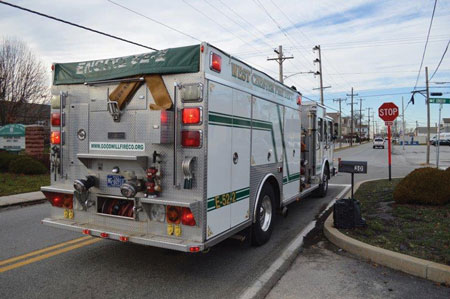 |
| (2) Even with emergency lights and sirens activated, fire apparatus operators must come to a complete stop at negative right-of-way intersections such as stop signs and red lights. Assuming that other drivers will see or hear you could lead to a serious crash. |
Sirens have not been able to keep up with the evolution of the modern-day car. Modern-day cars have roofs, doors, and sound-insulating material that are designed to keep sound out (photo 1). As a result, it is more difficult for a siren to penetrate the structure of a modern vehicle and effectively warn another motorist of an emergency vehicle’s approach.
Ambient Noise
Sound is measured in decibels. A sound that is perceived to be more “loud” will have a higher decibel reading than a sound that is perceived to be “quiet.” Table 1 shows examples of different sounds and their corresponding decibel levels.
There is a substantial amount of noise inside the passenger compartment of a vehicle, called “ambient noise.” Ambient noise is a direct result of such things as the radio setting; the heating, ventilation, and air-conditioning (HVAC) system; engine noise; and the road noise from the tires.
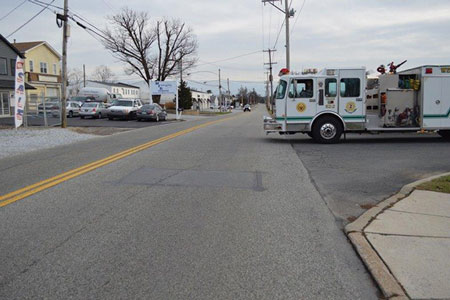 |
| (3) Be aware of sticking the front of the apparatus into a lane of traffic. This is especially true as fire apparatus operators creep forward in an attempt to see around a sight obstruction or they creep through a negative right-of-way intersection. A driver may not see the bumper because of the lack of emergency warning lights. |
The average civilian vehicle traveling at 45 miles per hour (mph) has an ambient interior noise level of about 65 decibels. This ambient noise level will change based on several factors, including the volume of the radio, the setting of the HVAC system, the type of road the vehicle is driving on, and whether or not the vehicle is accelerating. The ambient noise inside the vehicle is also related to how fast the vehicle is traveling. The faster the speed, the louder the ambient noise will be.
For a siren to break a driver’s concentration and register as an approaching emergency vehicle, studies show that the siren will need to rise approximately 10 decibels above the ambient noise inside the passenger compartment of a civilian vehicle.1 If the ambient noise inside the passenger compartment of the vehicle is 65 decibels, the siren must rise to approximately 75 decibels to break a civilian driver’s concentration.
Insertion Loss
Today’s modern vehicles are designed to keep sound out. Studies show that an average vehicle will block approximately 30 to 40 decibels of sound from penetrating the structure of the vehicle. Therefore, if a civilian driver requires 75 decibels of siren noise to break his concentration, and the car blocks 35 decibels of siren noise, the siren will have to be at least 110 decibels directly outside the driver’s window. This difference is known as “insertion loss.”
When discussing insertion loss, you must understand that sounds are made up of different frequencies. Some are made up of low frequencies and others are made up of high frequencies. The structure of a modern vehicle is more effective at blocking sounds made up of higher frequencies. Unfortunately, most emergency vehicle sirens are in this high-frequency range. As a result, the structure of a civilian vehicle is very effective at blocking a siren.
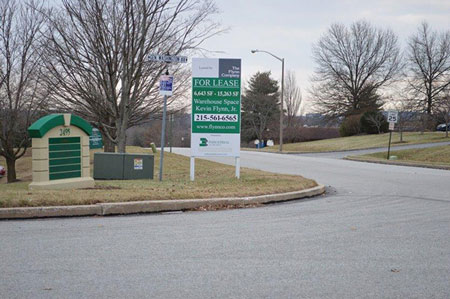 |
| (4) Be wary of sight obstructions on intersection corners. Signs, buildings, and vegetation can prevent civilian drivers from seeing an emergency vehicle and vice versa. |
Some siren manufacturers have sought to solve the problem of insertion loss by manufacturing low-frequency sirens. These sirens are designed to better penetrate the structure of a civilian vehicle by reducing insertion loss. However, low-frequency sirens are not as loud as a typical siren. As a result, they still have a relatively limited effective range. The concept of a low-frequency siren is a good one, but it is still not the final solution.
Consider this: If a vehicle is two blocks away and the driver is listening to opera music, you probably won’t hear the opera music if you are standing on the corner. However, if the same driver is listening to music that has a lot of deep bass, you will probably hear the vehicle coming from a long way off. The same goes for low-frequency sirens.
Distance from and Volume of the Siren
On average, to effectively warn a civilian driver who is driving at highway speeds with the radio on, the siren will need to arrive outside the driver’s window at 110 decibels. The actual required decibel reading will depend on issues such as the ambient noise inside the passenger compartment of the civilian vehicle, the insertion loss of the vehicle, and the condition of the driver.
Testing shows that most sirens average approximately 124 decibels at 10 feet in front of the siren; this is the maximum sound pressure level produced by the siren. The actual sound pressure level will change based on how the siren “sweeps.” Sirens tend to sweep up and down, increasing and decreasing in volume; 124 decibels at 10 feet is typically the best-case scenario. In theory, as the distance from the siren doubles, the measured sound pressure level will decrease by six decibels. This concept is known as the Inverse Square Law.
Keep in mind that this six-decibel reduction is in an ideal laboratory environment. Actual testing has revealed that the reduction in sound pressure will be affected by how the sound “spreads” out from the siren speaker as well as by the reflectivity of the surrounding materials (asphalt, buildings, and so on).
![Examples of various sounds and their corresponding sound pressure levels [in decibels (dbA)].](https://emberly.fireengineering.com/wp-content/uploads/2017/02/1702FE_55.jpg) |
| Examples of various sounds and their corresponding sound pressure levels [in decibels (dbA)]. |
The six-decibel reduction also depends on the approach angle of the emergency vehicle. One study has demonstrated that the reduction in sound pressure level can be as high as 11 decibels when the emergency vehicle approaches a 90° intersection instead of approaching from the rear.2
Figure 1 shows that as the distance from the siren is doubled, the measured sound pressure levels reduce dramatically. The question is, at what point can the siren no longer be heard effectively inside the civilian vehicle? Assuming the siren needs to arrive at the driver’s window at 110 decibels, the effective range of a siren averages no greater than 80 feet. This effective range could be much lower depending on the geography and geometry of the intersection or if obstacles block the path of the sound.
A study conducted in 1977 by the United States Department of Transportation (DOT) confirmed this limited effective siren range. (2) The study demonstrated that the effective range of a siren at a 90° intersection in an urban environment was no greater than 40 feet. In a rural situation, the effective siren range was less than 12 feet. The results of this DOT study were corroborated by tests I conducted (Tables 2 and 3).
Localization of the Siren
Once the siren penetrates the civilian vehicle and breaks the driver’s concentration, the driver must “localize” the siren. “Localizing” the siren means figuring out where it’s coming from. It is difficult to localize a siren while seated in a vehicle. The structure of the vehicle will redirect the siren sound from its original direction and reflect it across the body of the vehicle. (2) This reflection of the siren sound will make it difficult for a driver to determine the directional approach of an emergency vehicle. In the study conducted by the DOT, drivers seated in a vehicle with the windows closed could only identify the correct location of the siren 26 percent of the time. (2)
 |
| Results of actual sound pressure level monitoring of various fire apparatus mechanical sirens. In these tests, the sound level meter was set 90° to the siren, to simulate an intersection approach. Because the sound level meter was set up 90° to the front of the siren speaker as well as issues related to the reflectivity of the surrounding environment, the sound pressure levels do not match the theoretical results expected using the Inverse Square Law. However, the results are quite close. |
This lack of localization may cause confusion for the civilian driver, resulting in a longer perception and reaction time as the driver tries to figure out from what direction the emergency vehicle is approaching. A longer perception and reaction time will cause the driver to take more time to yield the right-of-way.
Reaction Time
After hearing and localizing an approaching siren, a civilian driver must decide what he is going to do to get out of the way. This may involve pulling over to let the emergency vehicle pass or coming to a stop to allow the emergency vehicle to pass through a negative right-of-way intersection.
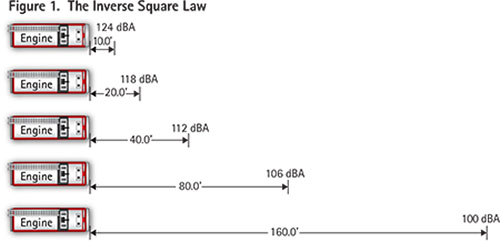 |
| The Inverse Square Law states that as the distance from the sound source doubles, the sound pressure level is reduced by six decibels. At 10 feet directly in front of the siren, most sirens will average 124 decibels. This chart demonstrates the significant reduction in sound pressure as the distance from the siren increases. Note that at a 90° offset (as at an intersection), this six-decibel reduction in sound pressure level could be much higher. Actual sound pressure readings will also be affected by the directivity of the siren speaker and reflectivity of the surrounding environment (see Tables 2 and 3). |
Apparatus operators must remember that this process takes time. On average, it takes approximately 1.6 seconds for a civilian driver to perceive and react to a problem. Reaction time may be higher in a more complex and unfamiliar scenario such as that of an approaching emergency vehicle.
As the civilian driver takes time to perceive and react to an approaching emergency vehicle, the two vehicles are driving toward each other, getting ever closer. Emergency vehicle operators must remember this and give civilian drivers time to see/hear the apparatus, decide what they are going to do, and then do it. This is why apparatus and emergency vehicles can’t just drive through a red light, ride someone’s bumper, or “push” a civilian vehicle off the road.
Intersection Safety
A misunderstanding of effective siren range is a common cause of emergency vehicle crashes. This is especially true when an emergency vehicle is attempting to cross a negative right-of-way intersection. Many apparatus operators assume that a civilian driver will hear the apparatus approaching the intersection in time to give the right-of-way. In reality, the civilian driver will not hear the emergency vehicle until it is too late.
A civilian vehicle traveling 45 mph will take approximately 195 feet to perceive, react, and skid to stop under ideal conditions on a dry road (Figure 2). If the civilian driver does not hear the siren until he is 80 feet from the apparatus, the civilian will have no time to process what is happening, put his foot on the brake, and skid to a stop. Instead, the apparatus will pull out in front of the civilian vehicle before the civilian driver can stop, resulting in a collision (Figure 3).
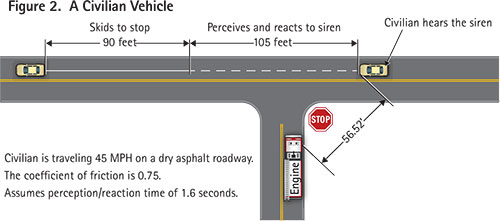 |
| A civilian vehicle traveling 45 mph on a dry asphalt road will take approximately 195 feet to perceive, react, and skid to a stop once the driver hears the siren. If the civilian hears the siren 40 to 80 feet from the intersection, he will have no time to yield the right-of-way before the apparatus pulls in front of him. |
This scientific fact regarding the limited effective range of a siren is the reason National Fire Protection Association (NFPA) standards [notably NFPA 1500, Standard on Fire Department Occupational Safety and Health Program (see sidebar)] and fire service best practices require an emergency vehicle operator to come to a complete stop at a negative right-of-way intersection. Apparatus operators must give the civilian driver time to see and hear the emergency vehicle, process the fact that an emergency vehicle is attempting to cross in front of him, and then give the civilian time to slow to a stop or pull over. Failing to come to a complete stop before driving into an intersection does not give the civilian driver time to yield the right-of-way.
Another common misconception is that a civilian driver will see the warning lights on an emergency vehicle far enough away to yield the right-of-way. The topic of emergency warning lights warrants an entire article in and of itself; however, apparatus operators must understand that the effectiveness of emergency warning lights is also limited. This is especially true in urban or suburban environments, which often have sight distance obstructions at the corners of the intersection. These sight obstructions will prevent a civilian from seeing an emergency vehicle attempting to cross an intersection. Don’t assume the driver will see you even if he doesn’t hear you!
When crossing a negative right-of-way intersection, follow these rules:
- Come to a complete stop (photo 2).
- Be wary of creeping too far into the intersection to a point where the front bumper enters the travel lane of the cross street. If an approaching civilian vehicle does not have time to grant the right-of-way, it may strike the bumper. This is especially true with the large, protruding bumpers common on modern fire apparatus (photo 3).
- Look both ways. Ensure that traffic is slowing down.
- Once civilian traffic on the cross street comes to a stop and yields the right-of-way, make eye contact with the civilian drivers. This will help confirm their intention to stop and allow you to cross. A wave of thanks also helps confirm their intentions.
- Cross the intersection slowly, keeping an eye out in both directions. This is especially true for multilane intersections.
- If there is more than one lane to cross, make sure to stop at each lane and repeat this process. Many apparatus crashes have occurred when the fire apparatus operator stopped on one side of the intersection and then “shot” across. Even if the civilian vehicles in the closest lane yield the right-of-way, drivers in the other lanes of traffic may not be able to see you.
- Once you have crossed the intersection, continue safely on your way.
Keep in mind that there may be times when you cannot see approaching traffic because of a sight obstruction, which may include a building, a sign, or a large tree on the corner (photo 4). Sight obstructions may also be caused by a large vehicle (such as a tractor trailer) that stops to yield the right-of-way but blocks the view of the other lanes of travel. In this case, you must wait for the sight obstruction to correct itself. If the obstruction is a vehicle that can move, wait for it to reposition.
If the sight obstruction can’t be corrected, the apparatus driver should wait for the light to turn green. Many apparatus operators question the need to wait for the light to turn green, but pulling out into a blind lane of travel is no different than playing Russian Roulette. If you can’t see what’s coming, you can’t pull out.
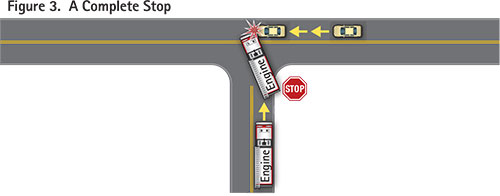 |
| If the fire apparatus does not come to a complete stop and give the civilian vehicle time to yield the right-of-way, a crash will result. |
Many areas of the country are equipped with traffic preemption systems that allow an emergency vehicle to change the color of the traffic signal from red to green. These systems also warrant an entire article; but on the most basic level, apparatus operators must have an understanding of preemption limitations. Traffic preemption systems are excellent tools when used properly. However, apparatus operators must understand how they work and need to give the system time to capture the preemption signal and change the traffic signal green. “Overdriving” the preemption system and not giving the traffic signal time to change could lead to a serious crash.
Many serious apparatus and emergency vehicle crashes occur at intersections. They are a direct result of emergency vehicle drivers failing to understand the limitations of their emergency warning devices; this is especially true of sirens. In addition, emergency vehicle drivers must understand the limited effective range of their siren and be sure to give civilian drivers enough time to perceive, react, and yield the right-of-way. Slowing down or driving through a negative right-of-way intersection without stopping may lead to disaster.
Training programs and EVOC classes must address the issue of siren and emergency warning light limitations. Failing to properly train emergency vehicle drivers on this topic will continue to perpetuate a lack of understanding regarding the need for complete stops at negative right-of-way intersections.
REFERENCES
1. Howard, Maddern, and Privopoulos. “Acoustic Characteristics for Effective Ambulance Sirens.” Acoustics Australia, Volume 39, August 2011, No. 2.
2. Potter, Fidell, Myles, and Keast. “Effectiveness of Audible Warning Devices on Emergency Vehicles.” U.S. Department of Transportation. August 1977, 91.
CHRIS DALY is a 26-year fire service veteran who has held numerous positions, including assistant chief, in career and volunteer departments. He is also a 19-year law enforcement veteran and a patrol supervisor in West Chester, Pennsylvania. He is an accredited crash reconstructionist (ACTAR #1863) and a lead investigator for the Chester County (PA) Serious Crash Assistance Team. He has a master’s degree in environmental health engineering from Johns Hopkins University and is a contributing author to numerous fire service publications including Fire Apparatus & Emergency Equipment and Fire Engineering. Daly developed an emergency vehicle driver training program titled “Drive to Survive,” which has been presented to more than 15,000 firefighters and police officers at more than 380 emergency service agencies across the United States.
NFPA 1500, Section 6.2.8 – During emergency response, drivers of fire apparatus shall bring the vehicle to a complete stop under any of the following circumstances:
NFPA 1500, Section 6.2.9 – Drivers shall proceed through intersections only when the driver can account for all lanes of traffic in the intersection.
NFPA 1500, Section 6.2.10 – During an emergency response or nonemergency travel, drivers of fire apparatus shall come to a complete stop at all unguarded railroad grade crossings and ensure that it is safe to proceed before crossing the railroad tracks.
Response to Fires
CODE 3 DRIVING
CREATING AN APPARATUS DRIVER RESPONSE SOP
Fire Engineering Archives

